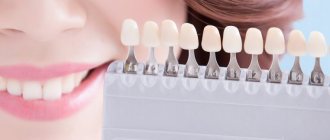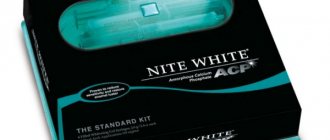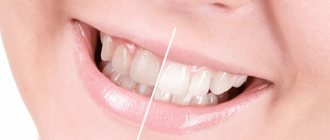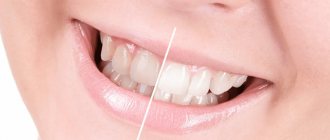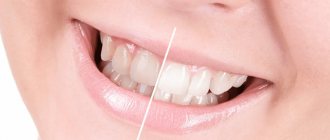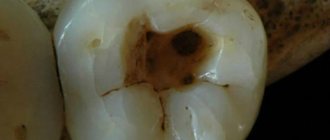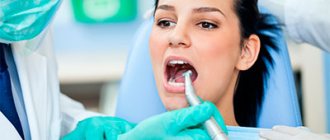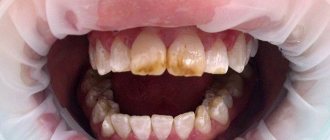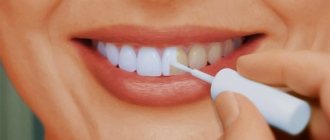Indications Is bleaching harmful?
Why do teeth darken? Whitening methods Safety of home whitening Whitening in dentistry Stages Care A snow-white smile is the dream of every person. And everyone is interested in safe teeth whitening. Many people have heard about bad experiences from friends and the Internet and are afraid to repeat these mistakes. But the procedure has been well studied, but it is important to know which Moscow clinic can provide truly high-quality and gentle teeth whitening.
Is whitening safe?
What is teeth whitening? This is a cosmetic procedure in which the color of dentin changes (namely, the color of the tooth depends on it) - lightening by several tones under the influence of active substances. Whether it is safe or not depends on the professionalism of the dentist, as well as on the technologies and drugs that are used for these purposes (these must be registered drugs, modern methods). If we are talking about whitening at home, everything is the same, only instead of a doctor, it is the rationality of a person.
ROOTT Clinic expert on the most important things when whitening
In general, whitening is a fairly safe procedure if the teeth have good mineralized enamel, healthy gums and good oral hygiene.
Regular cleaning with baking soda
To quickly whiten your teeth, simply brush them with baking soda. Daily cleaning damages the enamel structure, so the procedure should be carried out no more than once every 4 months. You need to brush the enamel gently and carefully, without unnecessary friction, and those places where plaque has accumulated can be rubbed harder.
How to properly brush your teeth with baking soda to whiten them:
- Take a toothbrush with soft bristles and wet it.
- Dip the brush into the previously prepared baking soda.
- Start cleaning the enamel, carefully treat areas where plaque has accumulated.
- Rinse your mouth with warm water several times to flush out the soda.
- Brush your teeth again with whitening toothpaste.
Remember that if you naturally have weak enamel and sensitive teeth, then you cannot brush with soda. This method is traumatic for the gums, so do not allow soda to get on the mucous membrane.
Also keep in mind that baking soda only whitens teeth, not fillings. They are not bleached as they are initially a darker color and will look darker after cleaning. Under the influence of the active components of the mixtures, fillings can also be destroyed, so try not to bleach them too often.
Indications and contraindications
Most often, the patient prescribes the indication for whitening to himself - he is not satisfied with the aesthetic appearance of especially the front teeth, which are visible when smiling. I want it to be whiter and more dazzling.
Darkening of the enamel can also occur due to frequent intake of coffee, cigarettes, dark berries and even medications.
But there are also a number of contraindications
:
- pregnancy and lactation;
- age under 18 years;
- allergies to drugs;
- the presence of fillings, crowns, veneers (they simply do not whiten);
- bracket systems, staples;
- cancer;
- hypersensitivity;
- active caries, periodontitis or other oral diseases;
- wedge-shaped defect (dentin exposed);
- rapid abrasion of enamel;
- in some cases diabetes mellitus.
You should definitely consult with your doctor about indications and contraindications so that together you can choose a safe method for teeth whitening. And of course, carry out a complete sanitation of the oral cavity to avoid uneven color after the procedure.
Before-after photos of teeth whitening at the ROOTT clinic
For what?
Cleaning with soda is an extremely popular, affordable and effective method that allows you to quickly remove plaque and lighten enamel using soda. This method is low cost and easy to use; everyone can try it out for themselves by spending a small amount of money.
However, this procedure also has a number of disadvantages. Firstly, such cleaning should not be performed more than once a week. The cleansing ability of soda is associated with its abrasive properties: small particles literally scrape off the thinnest outer layer of enamel along with the plaque pigment embedded in it, after which the teeth become lighter and cleaner. However, tooth sensitivity often increases - and this is another disadvantage of brushing with soda.
What harm can bleaching cause?
The safest teeth whitening will be under the supervision of a professional dentist. Indeed, with inept management and the wrong approach, a number of troubles can arise:
- Negative effects on tooth enamel of incorrectly selected concentrations of bleaching agents. This is both increased sensitivity and an increase in the microporosity of its structure. Over time, the ingestion and accumulation of food dyes may cause the tooth color to become even darker than before;
- chemical burn of gum tissue due to improper isolation;
- uneven lighting.
Content:
- How to whiten teeth
- Effective dental techniques you can trust
- Unprofessional whitening
- How to whiten teeth - composition of special dental gels
- How to do teeth whitening
- How to extend the result
- Possible complications after whitening
- Contraindications
Patients most often decide to whiten their teeth for aesthetic reasons. This procedure today can rightfully be called one of the most popular among those provided in a dental clinic. And this is not surprising - after all, according to most people, a beautiful smile must be snow-white.
What whitening methods are there?
The dentist will advise which teeth whitening is safe for each patient individually. But everything that takes place under the supervision of a doctor will definitely not harm - there is no doubt about it, especially when using the latest technologies, delicate compounds and modern developments.
Professional teeth whitening methods:
- Photobleaching;
- laser whitening;
- whitening gel only;
- hardware method.
The first two methods use a lamp or laser as a catalyst for the action of the whitening gel.
Photobleaching, for example, ZOOM, enhances the effect of active hydrogen peroxide, helping to quickly break it down into free radicals - oxygen atoms. of up to 10 tones occurs.
. With proper care, the results last for several years.
The laser procedure differs in that instead of a light beam, a laser beam acts. It can heat the surface, which causes sensitivity (everything is in the hands of a professional doctor, since the advantage of a laser is accuracy), and copes well with changing color by 10-12 tones
and maintaining it for up to 5 years. The downside is the high cost of the method.
Dentists are still arguing about what is the safest teeth whitening, and whether laser and light are necessary for the best results. But it has been proven that the method of applying gel without using them is also effective. Opalescence technology with 40% hydrogen peroxide in the gel is cheaper in price and has proven itself in aesthetic dentistry.
A simple dental cleaning at the clinic is often sufficient for many people. After removing stones and plaque, the teeth become several shades lighter. Using one of these methods:
- Air-Flow hardware cleaning (the principle is similar to a sandblasting machine, but instead of sand, soda);
- ultrasound.
You can be satisfied with the result of your renewed smile.
Teeth whitening with soda: methods
By using baking soda in the indicated quantities and following the process of applying it to your teeth, you can lighten them effectively and without harm.
You can use soda in several ways, each individual will choose a convenient option for himself.
Easy way
In this case, pure soda powder is used. It should be applied to a piece of gauze (previously soaked in water), a cotton swab, a finger, in rare cases, if you are sure that the enamel on the teeth is thick, then pour soda directly onto the toothbrush.
One of the selected tools needs to process each tooth separately.
Then rinse your mouth well and brush your teeth with regular toothpaste. Rinse everything again. After the first use, the color of the tooth enamel will become one (and in some cases two) shades lighter.
But this method of whitening can be used no more than 4 times a month, otherwise the abrasive particles present in the soda powder will intensively destroy the integrity of the enamel. The danger is that they act at a micro level and their harm will not be immediately noticeable!
Sometimes there are options for using soda powder together with toothpaste, but there is a high probability that it will neutralize the effect of some of the components of the paste, and the result will not be able to take hold.
Tasty way
In the summer, fragrant strawberries will help with teeth whitening. It contains malic acid, which enhances the effect of soda and helps achieve effective whitening. There are several recipes for preparing such a bleaching composition:
Recipe No. 1
Grind the strawberries into puree and add 1/3 of the resulting volume of soda to the resulting mass.
You should first brush your teeth with toothpaste, and then apply the strawberry whitening composition to them and leave it on for 10 minutes.
For the first time, five minutes will be enough. If the enamel is thin, then the exposure time can be reduced. After the procedure, your teeth need to be brushed again with a paste that definitely contains fluoride.
Recipe No. 2
Mash one medium strawberry and add 1 teaspoon to it. without a slide of soda. Stir the mixture until a homogeneous consistency is obtained, and then take the mixture in small parts and rub it into your teeth in a circular motion. It should take no more than three minutes to treat the entire oral cavity, then rinse out the remaining mixture thoroughly.
This composition is very aggressive, so it is so important not to exceed the time of its use so as not to scratch the enamel.
Peroxide method
This option has a strong whitening effect, since when baking soda and hydrogen peroxide are combined, an aggressive mixture is formed. It can be used by people with thick enamel, otherwise these components can make teeth hypersensitive and even provoke periodontal disease.
The sour way
With this bleaching option, lemon is used, or rather its juice. In the recipe, there are two parts of soda for one part. If the amount of lemon ingredient is greater, this can cause deterioration in the condition of the enamel, and lead to an increase in its porosity, and as a result, the appearance of caries.
So, for those who are afraid to risk the condition of their teeth, it is better to use lemon peels. To whiten, you need to chew them, but not more than 4 times a month, because the acid they contain can corrode the enamel.
Three-component method
It involves the use of: soda, hydrogen peroxide and lemon juice.
To prepare the bleaching composition, you need to maintain the following proportions:
- 0.5 tsp each lemon juice and soda;
- 5 drops of 3% hydrogen peroxide.
This mixture is applied to the teeth with your fingertips. In this case, the brush cannot be used. The composition is applied carefully, and you need to avoid getting it on the gums.
This method increases the sensitivity of the teeth, after which you should not eat hot or cold foods for an hour.
Each of the above methods can have a whitening effect; when choosing one of them, you need to take into account the condition of your teeth and enamel.
Is it possible to whiten teeth safely at home?
The market offers more and more varieties of home whitening methods, whether they are safe or not - everything is individual. And the course usually lasts 10-20 days. However, not everyone is of any use.
Manufacturers offer:
- Whitening strips;
- mouth guards with active composition;
- felt-tip pens, markers;
- toothpastes with whitening effect.
All products contain the same hydrogen peroxide, but in a much lower concentration. Therefore, it will be possible to lighten and visually change the color of the enamel by 1-2 tones.
Rather, this is a lightening procedure, that is, you can safely bleach if you agree to change the shade by just a couple of tones, and are willing to spend a lot of time for a relatively small result.
But using professional products at home is not recommended. Is it dangerous.
Causes of darkening and yellowing of enamel
- Individual characteristics and age
By nature, enamel can be yellowish, grayish or white. These are innate characteristics that are in no way related to external factors. It is possible to change the color of such enamel, but the possibilities are limited.
The same goes for age. Over the years, the color of teeth usually becomes darker. This is a natural process.
- Water composition
To a certain extent, fluoride contained in tap water is beneficial for teeth. But if its level is elevated, then the risk of fluorosis – dull white or yellowish spots on the surface of the enamel – increases. Fluorosis usually affects the visible surfaces of the teeth - the upper front incisors, and is very difficult to treat.
Fluorosis: dull white spots spoil the appearance of the enamel
- Dental care
Insufficiently thorough hygiene is the reason that plaque remains on the teeth and gradually hardens. In hard-to-reach places - between the teeth, near the roots - it mineralizes and turns into stone. Typically, such deposits acquire a yellowish, brown color, and can be almost black.
Tartar is hardened plaque
- Nutrition and habits
Black tea, coffee, and red wine leave dark pigments on the teeth. Smokers' teeth darken due to the fact that the tars contained in tobacco smoke settle on them. With frequent use, ordinary cleaning and even professional hygiene do not restore the natural whiteness of teeth, because the enamel itself darkens due to pigments.
- Other external factors
There are a number of medications that can affect the color of enamel. Moreover, the side effect can appear decades after treatment. Defects such as darkening due to medication are almost impossible to whiten, since the pigmentation in this case is located in the deep layers of the enamel.
Tetracycline teeth - darkening due to antibiotics
Safe whitening steps
- It is necessary
to carry out professional oral hygiene a few days - Isolation of soft
gum tissue. If you isolate the gum incorrectly, the patient will receive a severe burn, which will lead to complications. Therefore, safe teeth whitening in dentistry should only be carried out by an experienced doctor specializing in this field. - A special gel
based on hydrogen peroxide is applied. It is updated every 15 minutes: it is removed from the surface of the teeth (as it develops its properties) and a new portion is applied. The gel is changed three times. - Activation of the gel using a special lamp
. The dentist places a special lamp, the light of which will activate the gel. It is necessary to speed up the procedure and reduce it to 1 hour. The lamp has a cold LED light that does not heat the enamel structure and the procedure is comfortable for the patient. - Removing gel
from the enamel surface and all insulating materials from the gum surface. - Procedure for strengthening teeth
. A gel is applied that strengthens tooth enamel and reduces sensitivity.
Whitening is carried out in the smile zone, from 5 to 5 teeth of the lower and upper jaw. The procedure takes on average 1 hour
. Anesthesia is not given. This is necessary so that there is direct contact between the patient and the doctor, and the former can report if discomfort or pain occurs. Otherwise, you may miss the moment when something went wrong: a burn to the mucous membrane, too aggressive exposure to the material, a person’s low pain threshold.
When and how many times should you brush your teeth?
You need to brush your teeth at least 2 times a day for 2 minutes, and you should try to distribute this time evenly over the entire dentition. It is best to brush your teeth before breakfast, since microorganisms accumulate in your mouth after sleep. Without brushing your teeth, you risk introducing pathogenic microflora into the stomach and intestines. In the evening, it is recommended to brush your teeth before going to bed and not eat after hygiene procedures.
Algorithm for proper brushing of teeth with conventional (traditional, manual) and electric brushes
It is recommended to follow the correct teeth brushing sequence:
- 1. First, rinse your brush or electric brush head under running water and apply a pea-sized amount of toothpaste to it.
- 2. Brushing your teeth begins with the outer surface of the side teeth, moving towards the middle. Proper brushing technique means holding the brush at a 45° angle. When using a regular toothbrush, it is necessary to perform the correct movements, namely, 4-5 sweeping movements from top to bottom on the upper jaw and from bottom to top on the lower jaw. When using an electric toothbrush, you do not need to make any movements other than moving it from the back teeth to the front ones, holding each for a few seconds without applying excessive pressure.
- 3. Then you need to perform similar actions on the inside.
- 4. Next, clean the chewing surfaces, also in the direction from the back teeth to the front, making circular movements.
- 5. Next you need to massage the gums with a brush using gentle circular movements. Electric toothbrushes have special attachments for the gums, palate and tongue.
- 6. Clean the surface of the tongue with a special device that should be on the brush, or use a special scraper for this.
- 7. At the end, clean the interdental spaces with dental floss, using a new piece of floss for each gap.
- 8. Finish brushing your teeth with a mouth rinse; you can use special rinses, which the doctor will help you choose at your appointment.
Using an irrigator
An irrigator is a device that uses a certain pressure to deliver a stream of water or antiseptic to clean the interdental spaces and other hard-to-reach areas, washing away plaque from the tooth enamel.
It must be used after brushing your teeth. Its use is most effective in the following cases:
- Wearing braces,
- The presence of bridges, crowns and implants,
- Tendency to form stones in interdental spaces, crowded teeth
- The occurrence of almond stones, causing bad breath.
The irrigator cannot be used for acute infectious and inflammatory diseases of the oral mucosa, damage to the oral cavity, or periodontitis.
Benefits and harms
Many people cannot decide whether they should use such cleaning or not. After all, the benefits and harms are almost equal. So what factors are beneficial and harmful ?
Benefit:
- availability;
- cost (very low price);
- soda powder does not cause allergies;
- restores blood circulation, and this strengthens the enamel;
- fights unpleasant odors and harmful bacteria;
- noticeable and quick effect;
- safety for the treatment of stomatitis in children;
- baking soda helps clean hard-to-reach places;
- a good disinfectant that helps cope with many oral ailments.
Harm:
- frequent use leads to destruction of enamel and bleeding gums;
- tooth sensitivity to hot and cold foods increases;
- if there is hypersensitivity to the components of the composition, the area around the mouth may become covered with red spots;
- gum injury;
- Scratches may appear on the enamel, and the structure of the tooth may be damaged;
- the result is short-lived, because the tooth surface quickly darkens.
How does the product work?
As has already been found out, soda is used to clean teeth and eliminate gum disease and caries.
For your information! It has been scientifically proven that products containing 30-60% baking soda can remove plaque.
Sodium bicarbonate is thought to increase the pH in the mouth, which counteracts the harmful effects of bacterial metabolic acids.
Sodium bicarbonate effectively removes plaque and acts as a polishing agent. But teeth can still react sharply to soda . For example, this happens if a person has thin or damaged enamel. The product begins to increase tooth sensitivity, the enamel becomes thinner.

